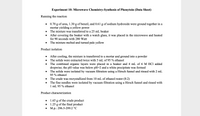
Chemistry
10th Edition
ISBN: 9781305957404
Author: Steven S. Zumdahl, Susan A. Zumdahl, Donald J. DeCoste
Publisher: Cengage Learning
expand_more
expand_more
format_list_bulleted
Question
Please provide experimental percent yield and theoretical yield

Transcribed Image Text:Experiment 10: Microwave Chemistry-Synthesis of Phenytoin (Data Sheet)
Running the reaction
0.70 g of urea, 1.30 g of benzil, and 0.61 g of sodium hydroxide were ground together in a
mortar yielding a yellow power
The mixture was transferred to a 25 mL beaker
After covering the beaker with a watch glass, it was placed in the microwave and heated
for 90 seconds with 280 Watt
The mixture melted and turned pale yellow
Product isolation
After cooling, the mixture is transferred to a mortar and ground into a powder
The solids were extracted twice with 5 mL of 95 % ethanol
The combined organic layers were placed in a beaker and 4 mL of 6 M HCl added
dropwise; the pH value was below pH=2 and a white precipitate was formed
The solids were isolated by vacuum filtration using a Hirsch funnel and rinsed with 2 mL
95 % ethanol
The crude was recrystallized from 10 mL of ethanol:water (8:2)
The fine needles were isolated by vacuum filtration using a Hirsch funnel and rinsed with
1 mL 95 % ethanol
Product characterization
1.65 g of the crude product
1.25 g of the final product
М.р.: 296.5-299.2 °C
Expert Solution
This question has been solved!
Explore an expertly crafted, step-by-step solution for a thorough understanding of key concepts.
This is a popular solution
Trending nowThis is a popular solution!
Step by stepSolved in 2 steps

Knowledge Booster
Learn more about
Need a deep-dive on the concept behind this application? Look no further. Learn more about this topic, chemistry and related others by exploring similar questions and additional content below.Similar questions
- Calculate limiting reagent and percent yieldarrow_forwardChoose the key item that must be determined experimentally in order to calculate the percent yield as follows Mol of product, or heat evolved, theoretical yield orarrow_forwardA student performed a chemical reaction that had calculated theoretical yield of 35.0grams. However, the student measured an actual yield of 32.5 grams. Calculate the percent yield?arrow_forward
- 1.99 g H2 is allowed to react with 10.3 g N2, producing 2.24 g NH3- Part A What is the theoretical yield in grams for this reaction under the given conditions? Express your answer to three significant figures and include the appropriate units. • View Available Hint(s) HÀ ? Value Units Submit Previous Answersarrow_forwardBACKGROUND KNOWLEDGE: The reaction performed is the precipitation of calcium hydroxide from solutions of calcium chloride and potassium hydroxide. The percentage yield of calcium hydroxide is 98.97% QUESTION: Comment on your calculated percentage yield and the main sources of error in this experiment.arrow_forwardHow to calculate percent yieldarrow_forward
- question → Can you calculate percent and theoretical yield? Final Eugenol mass: 127.13g - 126.2g = 0.93g Eugerol CHO carbon 12.011 x 10 = 120.01 Hydrogen 1.0078 x 12 = 12.0936 = 164.1016= Molar mass of 10 12 2 Eugenol oxygen 15.999 x 2 = 31.998 moks of Eugerol = 0.00566722 p 0.93 0.93 164.1016 = 0.00566722 + 10.0g = 0.0851 0.93 Garrow_forwardWhat is the computation for the theoretical yield of benzoic acid?arrow_forwardThe maximum amount of product that can be obtained under the given experimental conditions theoretical yield actual yield O percent yield limiting reagent excess reagentarrow_forward
arrow_back_ios
arrow_forward_ios
Recommended textbooks for you
 ChemistryChemistryISBN:9781305957404Author:Steven S. Zumdahl, Susan A. Zumdahl, Donald J. DeCostePublisher:Cengage Learning
ChemistryChemistryISBN:9781305957404Author:Steven S. Zumdahl, Susan A. Zumdahl, Donald J. DeCostePublisher:Cengage Learning ChemistryChemistryISBN:9781259911156Author:Raymond Chang Dr., Jason Overby ProfessorPublisher:McGraw-Hill Education
ChemistryChemistryISBN:9781259911156Author:Raymond Chang Dr., Jason Overby ProfessorPublisher:McGraw-Hill Education Principles of Instrumental AnalysisChemistryISBN:9781305577213Author:Douglas A. Skoog, F. James Holler, Stanley R. CrouchPublisher:Cengage Learning
Principles of Instrumental AnalysisChemistryISBN:9781305577213Author:Douglas A. Skoog, F. James Holler, Stanley R. CrouchPublisher:Cengage Learning Organic ChemistryChemistryISBN:9780078021558Author:Janice Gorzynski Smith Dr.Publisher:McGraw-Hill Education
Organic ChemistryChemistryISBN:9780078021558Author:Janice Gorzynski Smith Dr.Publisher:McGraw-Hill Education Chemistry: Principles and ReactionsChemistryISBN:9781305079373Author:William L. Masterton, Cecile N. HurleyPublisher:Cengage Learning
Chemistry: Principles and ReactionsChemistryISBN:9781305079373Author:William L. Masterton, Cecile N. HurleyPublisher:Cengage Learning Elementary Principles of Chemical Processes, Bind...ChemistryISBN:9781118431221Author:Richard M. Felder, Ronald W. Rousseau, Lisa G. BullardPublisher:WILEY
Elementary Principles of Chemical Processes, Bind...ChemistryISBN:9781118431221Author:Richard M. Felder, Ronald W. Rousseau, Lisa G. BullardPublisher:WILEY

Chemistry
Chemistry
ISBN:9781305957404
Author:Steven S. Zumdahl, Susan A. Zumdahl, Donald J. DeCoste
Publisher:Cengage Learning

Chemistry
Chemistry
ISBN:9781259911156
Author:Raymond Chang Dr., Jason Overby Professor
Publisher:McGraw-Hill Education

Principles of Instrumental Analysis
Chemistry
ISBN:9781305577213
Author:Douglas A. Skoog, F. James Holler, Stanley R. Crouch
Publisher:Cengage Learning

Organic Chemistry
Chemistry
ISBN:9780078021558
Author:Janice Gorzynski Smith Dr.
Publisher:McGraw-Hill Education

Chemistry: Principles and Reactions
Chemistry
ISBN:9781305079373
Author:William L. Masterton, Cecile N. Hurley
Publisher:Cengage Learning

Elementary Principles of Chemical Processes, Bind...
Chemistry
ISBN:9781118431221
Author:Richard M. Felder, Ronald W. Rousseau, Lisa G. Bullard
Publisher:WILEY